#wakayagi
Text
The look of... VI: Morioka
Welcome to the 17th installment of this series (my 6th). This time, we’re having a look at the Geigi that work in Morioka.
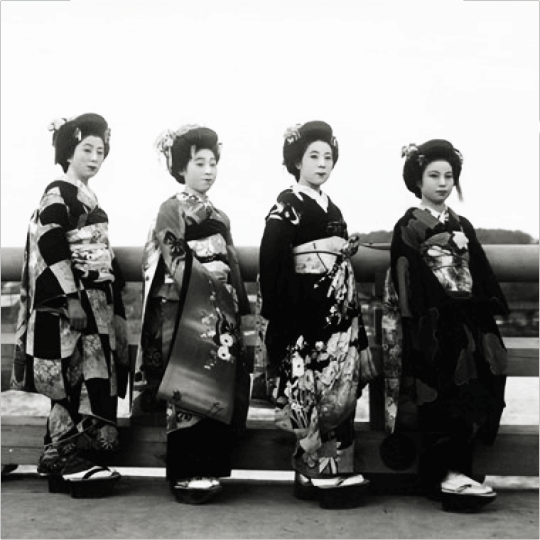
Historical context
It's not known when Geigi in Morioka started to exist, but they trained with Tokiwazu Rinchu 常磐津林中 who lived in Morioka from 1892-93. At this time, Morioka had two Hanamachi: Hatamachi 幡街 and Honmachi 本街. Hatamachi was frequented by customers of the merchant class, whereas Honmachi was the government office district, so the Ryotei there were mostly frequented by government workers and politicians.
From 1898 onwards, they were training dance with Wakayagi Rikiyo I 初代若柳力代, originally a Kabuki actor who turned to teaching in his later carreer.
In 1911, 54 Geigi worked in Hatamachi and 41 in Honmachi. 30 Ryotei operated in the entire city.
In 1913, the Morioka theatre was opened and the Joruri piece "Hanabutai chiyo kaomise" 花舞台千代顔見 was composed by Matsumoto Koshiro VII 七代目松本幸四郎, who invited the Morioka Geigi along him. The lyrics were passed down orally along with the choreography. This joruri piece is performed by the Geigi up to this day.
Coming to the present day, the segregation of "Hatamachi" and "Honmachi" no longer exists. They are all "Morioka Geigi", no matter where in the city they live. The Kenban no longer exists and there are no Okiya, all Geigi are independent. After a span of 19 years with no fresh blood, two young Geigi debuted in Morioka in 2012, followed by two Hyoko (Maiko) in 2016.

The look of Morioka Maiko
Local Term: Hyoko ひよ妓 - used to be called Hangyoku 半玉
※ Hairstyle: Momoware Katsura
※ Kanzashi: Manjugiku 萬寿菊 all year (2 sets: white/pink/green, white/red/green). Katsuyama and Daikan. First year with Shidare. Rice husk in the new year period. 1 Birabira, 1 Hirauchi, red Kanoko
※ Makeup: Oshiroi, both lips painted
※ Haneri: red with white embroidery, seldomly white
※ Kimono: Furisode without tucks
※ Obiage: flat, tied in the back. red/silver, red/white shibori, July-September: single colour pink and light yellow, white
※ Obi: Koken musubi
※ Obijime: round, flat, single knot
※ Footwear: Zori

The look of Morioka Geiko
Local Term: Geigi 芸妓
※ Hairstyle: Geiko shimada
※ Kanzashi: Kushi, Maezashi, rice husk in the new year period
※ Makeup: Oshiroi, both lips painted
※ Kimono: Homongi, Kurotomesode
※ Haneri: white
※ Obi: Taiko musubi
※ Obiage: red, pink, white with red Shibori (with Kurotomesode always white/red), white
※ Footwear: Zori


Casual look
Young and old Geigi alike often opt for a simpler look, both when dancing and when playing Shamisen…
※ Hairstyle: Yohatsu
※ Kanzashi: none
※ Makeup: no Oshiroi
※ Kimono: Homongi, Kurotomesode
※ Eri: white
※ Obi: Taiko musubi
※ Obiage: white
※ Footwear: Zori
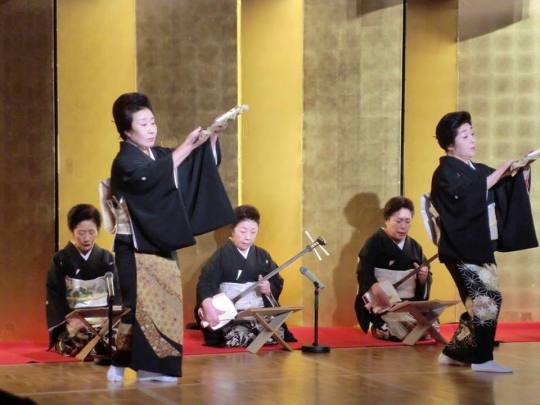

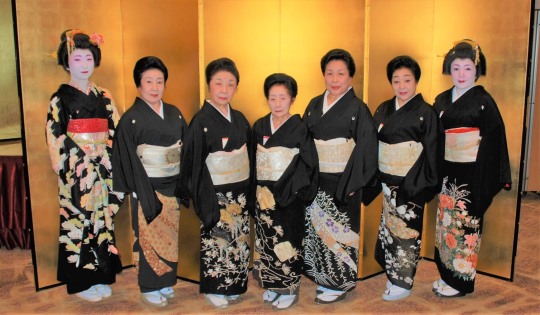
Dances
In comparison to other small Hanamachi, more than just two or three dances of their repertoire have been documented:
※ Aki no yo 秋の夜
※ Enkaina 縁かいな
※ Furyufunazoroi 風流船揃
※ Hanabutai Chiyo Kaomise 花舞台千代顔見
※ Haru kasumi 春霞
※ Harukoma 春駒
※ Kimigayo Shochikubai 君が代松竹梅
※ Kishi no Yanagi 岸の柳
※ Kanayama odori karame bushi 金山踊からめ節
※ Mori no nagame 杜の眺め
※ Nanbu ondo 南部音頭
※ Natsu to kabocha 茄子とかぼちゃ
※ Sekizoro せきぞろ
※ Yama wa iro nasu 山は色なす
※ Yûgure 夕暮れ
Check out the video linked below, the channel has more videos of this kind.

Notes
※ The joruri piece "Hanabutai Chiyo kaomise" received updated lyrics in 2013, reflecting the passage of 100 years after its creation. It's now called "Hanabutai Chiyo kaomise - Heisei version" 平成版 花舞台千代顔見.
※ The local term for the registry office was chosen to be "函番". Mostly pronounced Kenban like the Geigi registry offices all over Japan, but also "Kanban". The "函" character was also used for the Shamisen case - Geigi's Shamisen were stored in the Kenban and from there, brought to the Ryotei if needed.
※ Geigi Yôko よろ子 is Wakayagi Rikiyo IV.
※ Apprentice Geigi start dance training first, beginner dances being Kanayama Odori and Nanbu Ondo. Second the start training Shamisen and third Nagauta.
※ The b/w photo of the hangyoku is literally the only photo of Morioka Gei-/Maiko from before 2012 I was able to find. You can see the girls are wearing their own hair, Hikizuri and Darari Obi. The style has changed drastically!
※ This particular feature on Morioka was requested by @geimaiko. Thanks for the impulse!
※ If anyone reads this far... I’m happy to explore more Hanamachi. If you have a request, feel free to drop it in my inbox. An overview of what has received in-depth research before, you can find here.
Sources
※ text: past Hanamachi, 1911 numbers, beginner training, school of dance Wakayagi-ryu, kenban/okiya system defunct, 1993 debut (only mentioned, no picture of it, sadly!), everything else
※ dances: hanabutai, harukoma, nanbu+karame+haru kasumi (video), aki+natsu, kishi, yama+enkaina+sekirozo, furyu, mori+yugure, kimigayo (followers-only account)
※ pictures: collage 1: beige flower furisode, Kikumaru/Marika debut, dark blue furisode, collage 2: all from Kikumaru’s instagram, Tomochiyo/Tomiyu debut, Kikumaru erikae, jikata in sepia tones, new year’s photo (Facebook), veteran geigi dancing (Facebook), 3 geigi dancing. Hangyoku.
[Facebook has been restricting browsing for people who are not logged in recently, so I can’t look up the exact sources. Kikumaru’s instagram is private]
※ Original layout: @geimaiko ♥
72 notes
·
View notes
Note
Hi! I'd like to learn about the different dance styles more in depth (the different moves, how to differentiate them from one another, their origins, etc). Especially hanayagi, wakayagi and inoue. I won't mind information for Onoe and Fujima as well. Are there any websites, videos or books out there that could help as information online, at least in english, is scarce. Thanks!
I honestly don't know where you'd find such information besides watching videos of dances and trying to spot the differences ^^;
8 notes
·
View notes
Photo
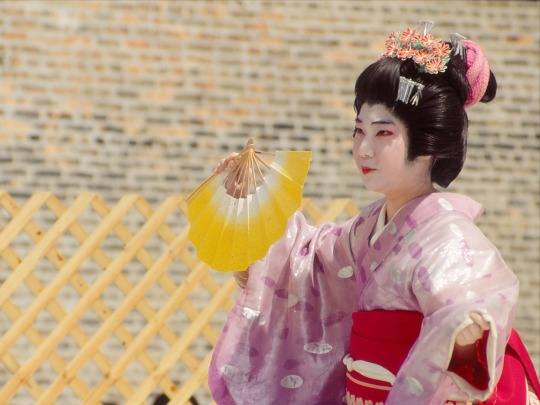
Wakayagi Shiyukai dancer, Chicago, 1993
#japanese culture#japanese clothing#japanese dancing#wakayagi#wakayagi shiyukai#film photography#35mm photography#ektachrome#1993
4 notes
·
View notes
Photo
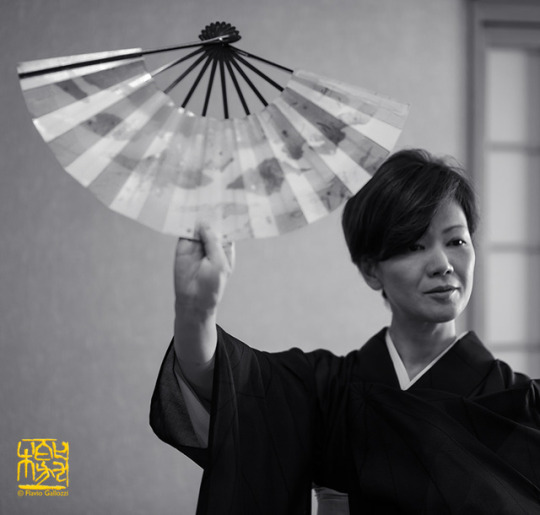
Dancing with fan, Wakayagi Kinshu Japanese dancer and teacher in Kyoto. Photo © Flavio Gallozzi - All rights reserved.
#dancer#dance#buyou#okinawa japan#japanese#Wakayagi Kinshu#kyoto#fan#hand#creative gesture#photography#photo#Flavio Gallozzi#photographer#blackandwhite#gesture
19 notes
·
View notes
Photo

เมษายน 2562: เกโกะ Toshimana (โอกิยะ Komaya), และไมโกะ Fukutomo (โอกิยะ Horiyae) จากเขต Miyagawacho หลังเวทีงาน Kyou Odori
Kyou Odori (京をどり) เป็นหนึ่งในสองของงานแสดงการร่ายรำประจำปีของไมโกะและเกโกะจากเขต Miyagawacho จัดขึ้นช่วงสองสัปดาห์แรกในเดือนเมษายนของทุกปี ซึ่งเป็นการแสดงศิลปะการร่ายรำจากสำนักสอนรำ Wakayagi ที่มีสอนเฉพาะในเขตนี้เท่านั้น
Source: toshi.m.n on Instagram
38 notes
·
View notes
Note
I've been really enjoying reading a lot of your spotlights lately, especially on the different districts. I was hoping that maybe you could do a little spotlight on the miyagawacho district, and the history behind it/ maybe the maiko and geiko within it and the traditions/ things they do differently. Thankyou !! ^_^
Let’s start with the basic facts again: Miyagawacho currently has 68 active members, 44 Geiko and 24 Maiko, and 17 active okiya and 33 active ochaya. Miyagawacho is Kyoto’s second largest hanamachi; Gion Kobu has 89 active Geimaiko, Pontocho has 59. They also have the second highest number of active okiya and ochaya, Gion Kobu has 22 active okiya and 61 active ochaya, Pontocho has 7 active okiya and 22 active ochaya. They have the highest number of active Maiko with 24, Gion Kobu has 23, and it’s usually just a little bit higher than that of Gion Kobu.
Their most recent Misedashi was Maiko Chikasome’s (Komaya Okiya) on the 21st of December 2016, and their most recent Erikae was Geiko Toshisumi’s (Komaya Okiya) on the 15th of June 2017.
Their most senior Maiko is Maiko Koume (Kaden Okiya), who had her Misedashi on the 8th of March 2012 and will have her Erikae in November, and their most senior Geiko is Geiko Mieko (Ishihatsu Okiya). Mieko had a very short Maiko-period, about two months long, because soon after she became a Maiko, wearing flashy clothing was prohibited due to war-conservation efforts and she was forced to become a Geiko on the 5th of March 1944. Mieko is currently 90 years old.
They dance in the Wakayagi Style of Dance, a pretty young dance school founded in the late 19th century, whose style is very close to Kabuki.
They hold two big annual odori, the Kyō Odori, which runs from April 1st to the third sunday of the month, and the Mizuekai, which will be held from the 12th to the 15th of October. They also hold a Yukata-Kai every July, although the date varies (this year it was the 12th), and participate in the Miyako No Nigiwai. They also hold a beer garden open to the public in summer, but I don’t know the exact dates from when to when it was running. It seemed to have run through a big part of July and August, though.
Miyagawacho’s biggest and wealthiest okiya are the Komaya Okiya (5 active Maiko, 5 active Geiko, three of them very famous) and the Shigemori Okiya (5 active Maiko, three active Geiko, one of them very famous). Two other well-situated okiya are the Kawayoshi Okiya (5 active Maiko, 1 active Geiko) and the Hanafusa Okiya (two active Maiko, two active Geiko, both Geiko famous senior Geiko).
In 1751, the first recorded licence for a tea house in Miyagwacho was granted and the area was already a popular entertainment-district before, which was mainly attributed to the fact that the famous Minamiza Kabuki Theater is located in Miyagawacho. Accordingly, Miyagawacho’s dance school is very close in style to Kabuki and many patrons of Miyagawacho’s ochaya used to be Kabuki actors, even to this day, to some degree.
Miyagawacho is the second youngest hanamachi of Kyoto; Gion’s teahouses (until 1886 it was called Gion Shinchi, usually shortened to just Gion, and consisted of both Gion Kobu and Gion Higashi) were officially licensed in 1665, Pontocho came into existence around the same time and Kamishichiken already came into existence in the late 16th century and was not only Kyoto’s, but Japan’s first hanamachi. Gion Higashi didn’t officially exist until 1886, when Gion Shinchi was split into Gion Kobu and Gion Higashi by the prefectural government.
Up until prostitution was outlawed in 1956, Miyagawacho used to license both Maiko and Geiko and prostitutes (yūjo), also including courtesans, Oiran. This led to Miyagawacho having a reputation as a “lower-class district” and still having to fight with a relatively low reputation, albeit its size (although it has become much more popular and highly-regarded over the last decades).
The fact that Miyagawacho used to licence Geimaiko and prostitutes means that some double-registered Geiko also lived and worked there. Double-registered Geisha were registered as both Geisha and prostitutes. As a part of their job as a Geisha, they would attend art classes normally and entertain clients with music, dance, drinking games and conversation and, as part of their job as a yūjo, would then sleep with some of their clients, too.
Double-registration only occured in districts that licensed Geisha and prostitutes and mostly affected very poor areas, as many Geisha in these areas couldn’t survive solely off of being a Geisha, and had to go to other means to make money, too. Double-registration never occured in most hanamachi, as most of them were popular and wealthy enough for their Geisha to solely live off their arts. Miyagawacho was also a very popular, bustling district, so it was much less affected than other areas of Japan used to be, so most Maiko and Geiko in Miyagawacho also were not double-registrated.
As Miyagawacho also licensed Oiran for a long period of time, and Oiran did not study the arts of the common people (the shamisen and Kabuki, for example), but those of the nobility (koto, kokyū and biwa, for example), today, Miyagawacho is the only kagai in Kyoto that still teaches the koto and the kokyū. They came from the Oiran and just kind of stuck around.
One of Miyagawacho’s biggest “peculiarities” is that they don’t have a clear distinction between tachikata (dancers) and jikata (musicians) Geiko, in which they are very similar to Pontocho, which also doesn’t have one. Miyagawacho’s Maiko and Geiko are encouraged to become proficient in both fields, and it’s very easy to change one’s registration from tachikata to jikata, and vice versa, if needed. Many Geiko appear as both jikata and tachikata in the KyōOdori, even young ones like Tanefumi (Takayoshi Okiya) and Toshimana (Komaya Okiya), and Maiko also receive a broad education in all arts.
This makes it very easy for older Geiko to continue their work as a pure jikata when they feel like they are too old for dancing. This is sometimes difficult for Geiko in other hanamachi, mostly Gion Kobu.
Kamishichiken also gives their Geimaiko a broad education in both music and dance and encourages tachikata Geiko to act as jikata during ozashiki (usually, the most senior Geiko will act as a jikata), examplified by the fact that Geiko Katsuna (Daimonji Okiya) was allowed to become a jikata after her Erikae, but they still have a clear distincton between jikata and tachikata during odori. This probably has a lot to do with how small they are and that they need their Geiko to be as versatile as possible
Gion Kobu has a very strict distinction between tachikata and jikata, and also doesn’t allows Geiko to debut directly as tachikata, only as jikata. A Maiko’s education also focuses on dance (although not exclusively), as the term “Maiko”, meaning “dancing child”, is understood very literally in Gion Kobu. Gion Higashi is in a different situation, best examplified by Geiko Masaki (Man Okiya): She debuted as a jikata, showed talent for dancing, was encouraged to take lessons and has had small a role in last year’s Gion Odori and has a bigger one in this year’s Gion Odori. This probably also has a lot to do with how small they are and that they need their Geiko to be as versatile as possible.
In Miyagawacho, Geiko get to up to five years to become independent, the longest time out of all of Kyoto’s hanamachi; Gion Kobu only gives them approximately one year, Pontocho gives them two and Kamishichiken and Gion Higashi give them three. Women debuting directly as Geiko, especially tachikata, often favor debuting in Miyagawacho, as it allows them the longest time to build a customer base and acquire their own collection of kimono, obi and hair ornaments. This is also the reason as to why most Maiko of Miyagawacho don’t order their own kimono for their Erikae, as they won’t need their own, very expensive kuromontsuki for a while. They’d rather rely on their okiya for a bit more and use the money for something else (you can buy two nice everyday-kimono from the money you need for one kuromontsuki, and then you’d still have some money left).
Only in Miyagawacho, it’s allowed for senior Maiko to be called to ozashiki without oshiroi and hikizuri, but in a simple komon (if specifically requested by the client) and, also only in Miyagawacho, senior Maiko are also allowed to dress up for Setsubun; in the other kagai, they only get to wear special hairstyles, like the junior ones.
Miyagawacho’s Maiko also start tucking in their obiage starting the day they become senior, as it’s seen as a sign of maturity. In Gion Kobu, the obiage is tied a month or two before the Maiko’s Erikae, in Pontocho, Kamishichiken and Gion Higashi, it’s tied within a year of the Erikae.
In Miyagawacho, much like Kamishichiken, senior Maiko can also be the host (otemae) of tea ceremonies, although it’s rarer than in Kamishichiken. As these tea ceremonies will usually happen before the KyōOdori and sometimes the Mizuekai, the Maiko will usually wear a formal kuromontsuki and the yakko shimada hairstyle. In Gion Kobu, Pontocho and Gion Higashi, Maiko only act as assistants (hikae) of tea ceremonies.
Prior to wearing the sakkōhairstyle, Miyagawacho’s Maiko will wear the yakko shimada hairstyle for about two weeks with an iromontsuki kimono, a completely red collar and their special sakkō-daikan. During sakkō, the Maiko will wear a formal black kuromontsuki with a golden obi and a completely red collar and their special sakkō-daikin. They can also do ohaguro (blacken their teeth with a special paste), it’s not obligatory, but encouraged (as in all hanamachi of Kyoto).
Miyagawacho has also worked with “Maiko-only-contracts” relatively often in the past, some okiya are especially well-known for it. It brings the okiya a great amount of money (Maiko do make a lot of money) and keeps Maiko-numbers at a certain minimum, and also saves them the very expensive Erikae, if they are not in a position to afford it. It enables the girls to get to know the karyukai while still being able to do something else in life, form connections that can be very helpful later in life, and also save a decent amount of money. Sometimes, Maiko who signed such a contract are allowed to become Geiko, though, if they really want to, their future career seems promising and the okiya can afford it.
This shows Miyagawacho’s relaxed atmosphere (for very traditional Kyoto, at least), as many other districts would not allow this. It always depends on the okiya, their financial situation and ultimately, the decision of the okaasan, though; not nearly every okiya in Miyagawacho does this.
Miyagawacho is pretty relaxed in general, which probably greatly attributes to the fact that they attract so many new aspiring Maiko every year. Not too long ago, there was a debate going on online about the fact that Geiko Kikutsuru (Hanafusa Okiya) is dying her hair brown, as many very traditional people don’t think it is appropriate for a Geiko to do that (although it’s still a pretty dark brown). Gion Kobu and Pontocho probably wouldn’t have allowed this at all, and I’m not even too sure about Kamishichiken and Gion Higashi. I think she looks great, just fyi ^^.
There is some friendly rivalry between all hanamachi of Kyoto, but especially between Gion Kobu and Pontocho, as they are considered the most high class, and Kamishichiken and Miyagawacho, as they are thought to be directly behind them in rank and are, by some, considered to be of “equal rank”. Kamishichiken is the oldest hanamachi of Japan, and therefore has the most tradition and history, but Miyagawacho is more than double its size (in numbers) and very popular. However, this really doesn’t go further than friendly rivalry during joint dance performances.
That’s all I could think about for now! If any of you have anything to add, please tell me so, and I’ll add it (and credit you, if you want to)! I hope the answer is satisfying ^^.
21 notes
·
View notes
Photo
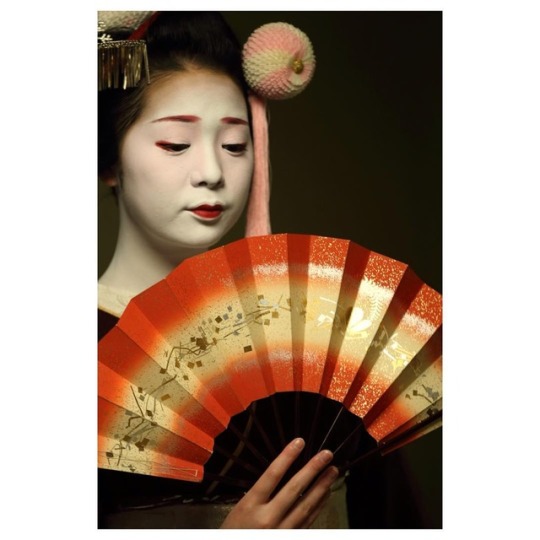
February 2017: maiko Fukutomo with a folding fan of Wakayagi school of dance by sonatina2525 on Instagram
༼ つ ◕◡◕ ༽つ Geisha-kai on P a t r e o n || Instagram
74 notes
·
View notes
Photo
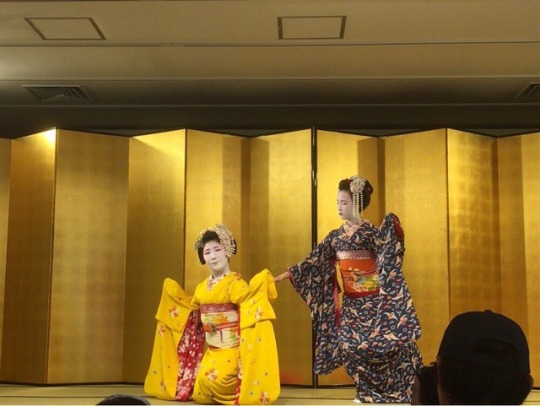


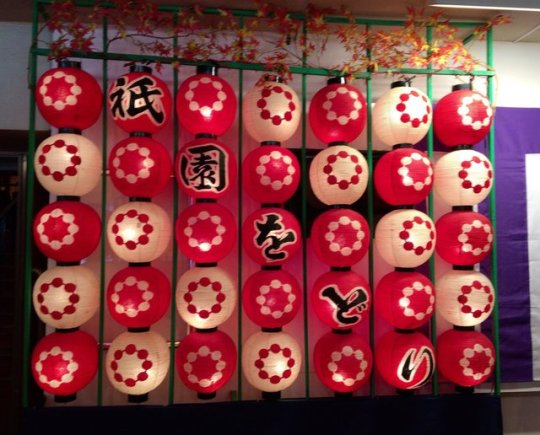

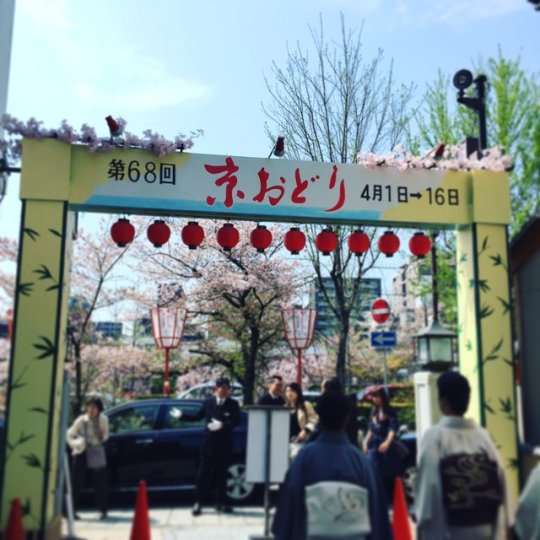

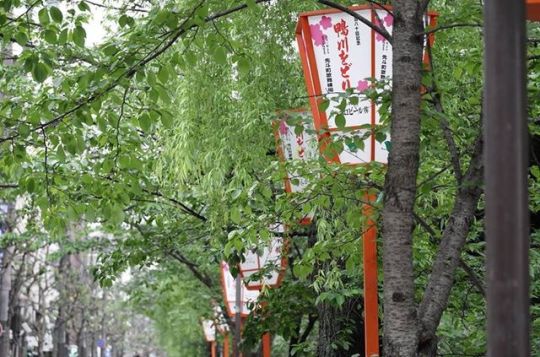

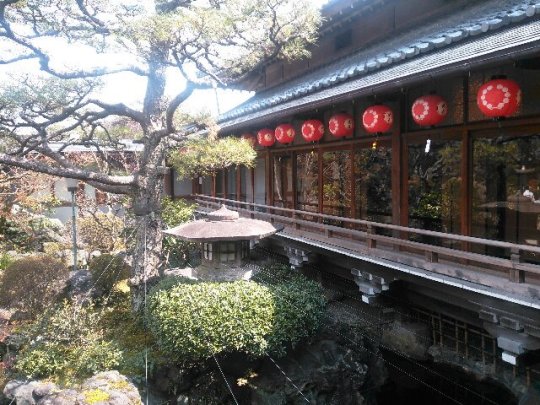
It is a flower street known for its glamorous appearance of geisha and maiko which is wrapped in atmosphere which is the most spectacular in Kyoto as much as the number of sights! Two flower streets of Gion east "Miyagawa Town" are adjacent to the flower street called "Gion 甲 部" of Higashiyama Ward. There are five other flower streets in Kyoto, "Pontocho" along the Kamogawa river and "Uena-echi" near Kitano Tenmangu Shrine. Every year, at these five flower streets "dancing feast" will be held to showcase the success of craft and traditional arts and daily training. · The Kyoto Kokubu also can be said to be synonymous with Fudo street! It is "taking the capital" to be held at "Gion Koza Dance Branch" from April 1 each year for one month. It was Meiji 5 that the "Miguartment" started. Kyoto lost its position as the capital since the Heian period in Tokyo Town (Meiji) after the Meiji Restoration, holding the "First Kyoto Expo" as a way to activate the town! It is the beginning of the "Miyako ni" that the master of the Gion "Ichiyotei" "Jiro Sugiura" is the center and was organized as "entertainment expo (attachment is Kuran)" of "Expo" 👯 Dance created a new collective dance that arranged the "Ko-no-koi dancing" of Kiseki III "Inoue Yasui" Ise Furuichi! Since then, "Migori Dori" has become established as an annual spring event, not only "Japan" but also a large number of tourists from all over the world are gathered · It will be held from November 1 to November 10 every year at "Gion Hall" "Gion dancing", as a performance in the flower street in Kyoto It is done only in "autumn". By the way, the dancer is called "cubic (tatakata)" song and the performance is called "district (jihata)". In the premiere, in the Showa 27 "Fujima Stream" director and choreography, the finale's "Gion Higashi Koure" will unleash the glittering stage of geiko and maiko's total! · Another flower street in Higashiyama Ward is "Miyagawa Town"! "Miyakawa Town Dance Drama", "Kyo Dance" will be held in April every year. "Kyoodori" that began in 1951, There was something that was held at the primary 'Namiza'. After Showa 44 years "Miyagawa Town Dance Drama" is set as the stage. Each dance in flower streets gathers gorgeous dance gently every year taking in "coloring of the four seasons" and "Kyo's sights" etc! "Kyoodori" was formerly "Umeito" flow, but now it is a wakayanagi (wakayagi) flow · "Ponto town dance drama" showing modern appearance of the Taisho era along the Kamogawa river was completed in 1927! Reinforced concrete buildings on the 1st floor of the 4th floor above the ground were then acclaimed as modern architecture with Oriental hobbies taken into account! "Pontocho" of "Pontocho" is "Chidori" invented at the premiere of Meiji 5 "Kamogawa Dori" ... "School of Kamogawa river" school is "Onoe" flow The feature features a dialogue with dice. In the past, since the show was held twice in spring and autumn, the number of performances is the largest in Five Flower Street 🍀 · "Kamikaze" next to "Kitano Tenman-gu Shrine" is the oldest flower street in Kyoto! When rebuilding "Kitano Tenman-gu Shrine" in the latter half of the 15th century, it comes from the fact that the "seven houses" tea shop was built with the remaining timber! "Taking Kitano" by directing "Hanayashi Stream" performed at "Kamikaze Dance Drama" Dance plays with a theatrical element are central, but new attempts are being done every year Five-flower street dance continues to be loved not only by Japan but also by people all over the world as an indispensable "Kyoto's style" together with the changing of the four seasons
3 notes
·
View notes
Note
How many dance styles do Geisha dance/exist all across japan? I know Kyoto has five different styles (inoue, onoe, etc.) How many exist in total?
Greetings,
there are hundreds of dance styles/schools "ryu" in all Japan. Those I know of (including Hanamachi that no longer exist, also some Hanamachi use multiple styles) are:
■ Bando 坂東 (Osaka Nanchi, Kamidayamada Togura)
■ Fujima 藤間 (Fukui, Hamamatsu, Isao, Kanazawa Kazuemachi, Kyoto Gion Higashi, Matsuyama, Osaka Nanchi, Otaru, Shizuoka, Takamatsu, Tamatsukuri, Tokyo Akasaka+Asakusa+Hachioji+Shinbashi+Yoshicho, Ureshino, Yamagata, Yugawara)
■ Fukuwara 福原 (Hamamatsu)
■ Hanayagi 花柳 (Atami, Gifu, Isawa, Kofu, Kumamoto, Kusatsu, Kyoto Kamishichiken, Nagasaki, Nara, Osaka Kitashinchi+Nanchi, Takasaki, Tokyo Asakusa+Kagurazaka+Oi+Omori+Shinbashi, Yoshicho, Yoshiwara, Ureshino)
■ Ichiyama 市山 (Niigata)
■ Inoue 井上 (Kyoto Gion+Gion Kobu)
■ Kamizaki 神崎 (Kanazawa Higashi)
■ Nishikawa 西川 (Aizuwakamatsu, Inuyama, Kanazawa Nishi, Kyoto Pontocho, Nagoya, Osaka Horie+Kitashinchi+Shinmachi, Tokyo Akasaka+Mukojima+Shinbashi)
■ Okamoto 岡本 (Yuzawa)
■ Onishi 小西 (Mito, Okayama)
■ Onoe 尾上 (Kinosaki, Kyoto Pontocho, Obama, Osaka Nanchi, Tokyo Shinbashi)
■ Rokugo 六鄕 (Kyoto Miyagawacho)
■ Saruwaka 猿若 (Tokyo Mukojima)
■ Shinozuka 篠塚 (Kyoto Gion, Pontocho)
■ Taguchiko 田口湖 (Tokyo Shintomicho)
■ Tanaka 田中 (Hakodate, Yugawara)
■ Umemoto 楳茂都 (Kyoto Miyagawacho)
■ Wakayagi 若柳 (Hanamaki, Kinosaki, Kyoto Miyagawacho+Pontocho, Morioka, Sapporo, Tosa)
■ Yamamura 山村 (Osaka Shinmachi)
■ Yoshito 芳膛 (Tokushima)
Annotations:
As for Osaka - it's possible that both Hanayagi and Nishikawa are still used in Kitashinchi, but I doubt that more than one school of dance is taught to Nanchi Geiko.
As for Kyoto - Rokugo and Umemoto are only used in the Kyo Odori, they might have been "everyday" styles once. Shinozuka was used in Pontocho up until the 1920s, and in Gion until the 1870s. As far as I know, Nishikawa and Wakayagi are no longer taught in Pontocho - they only use Onoe ryu now.
Source:
Tsurukomaiko "Dance + Music Styles of the Hanamachi" https://www.tapatalk.com/groups/tsurukomaiko/viewtopic.php?p=87622
25 notes
·
View notes
Note
What is specifically 'Kyomai' - for example the Fujima, Wakayagi, Hanayagi and Onoe dance styles are not unique to Kyoto - so what is 'Kyomai' referring to specifically? As I often see it used generally (regardless of Kagai) in reference to the dancing of Gei/Maiko in Kyoto.
Kyomai specifically is a dance style that has originated in Kyoto, which is to say that of the imperial court. Fujima, Wakayagi, and Hanayagi all originated outside of Kyoto and have roots in kabuki, which was focused in Edo (Tokyo). Onoe is a bit of an outlier as its founders have roots in kabuki, but in Kyoto and not Tokyo. It's too young of a style to be considered Kyomai ^^
12 notes
·
View notes
Note
Do onsen geisha go through the same training non onsen geisha go through? Are their duties the same as the other geisha's duties? What dance schools are they associated with?
Yes, geisha who work in onsen towns go through the same training as geisha from other cities. Their duties are the same too! There's many onsen towns, and they don't all follow one school of dance. However, some examples include Hanayagi for Atami, Wakayagi for Tosa, Onishi for Mito, Fujima for Fukui, and the list goes on ^^
19 notes
·
View notes
Note
Is the Inoue school the only dance school with their kamon on their mai ogi?
No, the Wakayagi school practiced in Miyagawa Cho also has their kamon on their fans ^^
10 notes
·
View notes
Note
Is Miyagawacho's dance school called Wakayagi or Wakayanagi? I've seen it both ways.
Thanks for this great blog. I've really learned a lot.
It's Wakayagi ^^
10 notes
·
View notes
Photo

Wakayagi Shiyukai dancer, Chicago, 1993
5 notes
·
View notes
Text
What’s In a Dance? Part 14
On The Eight Day Of Fun I present... another returning feature! It’s baaaaack! I got a few requests for new songs past few months, so I chose one that’s very fitting right now with the new year upon us. However things are not always what they seem.
Ume Wa Saitaka (梅は咲いたか) - Did The Plum Blossoms Bloom?

Image courtesy of Girasolemurano on Instagram.
This song is really beautiful, but there’s one glaring issue: there are two different versions performed in the karyukai. Sometimes they can be divided by kagai, but the reasons for such a divide aren’t clear
Lyrics
Ume wa saitaka, sakura wa madakaina, yanai nayonayo kaze shidai,
梅は咲いたか, 桜はまだかいな, 柳なよなよ風次第,
Did the plum blossoms bloom? Are the cherry blossoms still there? The willow bends depending on the wind,
Yamabuki ya uwaki te, iro bakkari, shongai na,
山吹や浮気で, 色ばっかり, しょんがいな,
The fickle mountain rose is only its color, shon gai na,
Ume ni shō ka, sakura ni shiyo kaina, iro wa midori no matsu ga eda ni,
梅にしようか, 桜にしよかいな, 色は緑の松が枝に,
The color, there on the verdant pine, will it be plum blossom or cherry?
Ume to sakura wo sakasetai shongai na,
梅と桜を咲かせたいしょんがいな,
I want to make the plum and cherry blossoms bloom, shon gai na,
Kinō kitakaze, kyō wa minamikaze, ashita wa ukina no tatsumikaze,
昨日北風, 今日は南風, 明日は浮名のたつみ(巽)風,
Yesterday, the north wind, today, the south wind, tomorrow, it is rumored to be the southeast wind,
Koi no kaze nara, irobakkari shongai,
恋の風なら, 色ばっかりしょんがい,
If love is in the air, it is only color, shon gai,
Yanagibashi kara kobune de kyū gase, fune wa yurayura nami shidai,
柳橋から小舟で急がせ, 舟はゆらゆら波次第,
From Yanagibashi I rush in my small boat, carried by the waves,
Fune kara agatte dote Yachō, Yoshiwara e goannai,
舟から上がって土手八町, 吉原へご案内,
From the ship we go up to the embankment of Yachō as we enter Yoshiwara,
Sakura sakura to ukareteiru waina, yayoi sangetsu hanamigetsu,
桜さくらと浮かれているわいな, 弥生三月花見月,
Many cherry blossoms float along, the third month that heralds spring and the fourth month of flower viewing,
Anata wa hana yori, sake bakkari shongai na,
あなたは花より, 酒ばっかりしょんがいな,
My love for you is more than those of the flowers, yet I am already drunk, shon gai na,
Asari toretaka hamaguri madakaina awabi kuyokuyo kata omoi,
浅蜊取れたか蛤まだかいな鮑くよくよ片想い,
Have the steamer clam been harvested? Are there still sushi clams? The abalone broods over unrequited love,
Sazae wa rinki de, tsuno bakkari shongai na,
栄螺は悋気で, 角ばっかりしょんがいな,
The turban shell is no more than the horns of jealousy, shon gai na,
Ginza hatchō ikō janai kai na, yama no kitsune ga shibake te,
銀座八丁行こうじゃないかいな, 山の狐が七化けて,
Let’s go to Ginza and see the mountain foxes change clothes quickly like the stage actors,
Kuroi mayu hiku, sode wo hiku shongai na,
黒い眉引く, 袖を引くしょんがいな,
Drawing black eyebrows, drawing down their sleeves, shon gai na,
Koi no Asakusa futari de iko kanai, nani wo Kototoi miyakodori,
恋の浅草二人で行こかいな, 何を言問都鳥,
Shall we go to beloved Asakusa, like the miyakodori of Kototoi,
Sue wa chidori de Namida Bashi shongai na.
末は千鳥で泪橋しょんがいな.
Or, in the end, will it be the plovers of Namida Bashi? Shon gai na.
The Breakdown
First off, you may have noticed that a good chunk of the lyrics were italicized; this is because each kagai tends to pick and choose which of those verses it adds on, so you won’t find a single version with all of the lines. The regular verses are the mandatory ones and the italicized verses are the optional ones. You may have also seen the addition on the end of many verses of “shon gai na,” which is kinda like our good friend “yoi yoi yasa” as in it’s there to add that bit of emphasis and rhythm. This is actually an old bit of colloquialism as it was almost like a type of slang when the song was written over 100 years ago. In its simplest terms, it’s an archaic way of saying “sou desu ka,” which means “is that so?”
The four types of plants elude to four different types of women in the karyukai. The plum blossoms refer to the young geiko as plum blossoms are the first to bloom in the spring. The cherry blossoms, on the other hand, represent more mature geiko who wait longer than the plum blossoms to bloom. Willows represent women who change to meet their various situations, but that makes them inconsistent and fickle. Mountain roses are a bit more nefarious as they represent women who are unfaithful and lie. Their yellow color is a symbol of frivolity when it comes to money, which usually then leads to heartbreak. Next, we're asked to wonder what color will bloom on the pine branch. The pine in this case is representing longevity and strength, and most likely a male customer, so they wonder whether a young geiko or a mature geiko will begin a relationship with them.
That being said, from reading the rest of the lyrics you may have been able to tell that this song predominately takes place in Tokyo and not Kyoto. Each of the places it mentions are popular spots in and around Tokyo. To begin, the term “tatsumi” is a play on words that actually represents the Tatsumi Geisha (辰巳芸者) who were found in the Fukugawa district. Next we’re lead around the city, from the famous Yanagibashi, which was once the most prestigious district in Tokyo, to Yachō, another district, and onto Yoshiwara by means of a small boat. The way that the narrator talks about Yoshiwara lets us know that they have a certain fondness for the area and are more of a connoisseur than a casual visitor. They make merry during March and April, the third and fourth months respectively, although when this was written it would have referred to the third and fourth months in the traditional Asian calendar. The narrator remarks about how their enjoyment is fleeting, just like the floating world in which they spend their time.
The inclusion of marine invertebrates seems really random, but it all serves a singular purpose. By harvesting the animals in turn you actually follow a cyclical calendar that takes you through an entire year. Being more specific, the steamer clams and sushi clams are both used for Kai Awase (貝合わせ), which is a shell matching game. Abalone and turban shells does not have a partner, so they stand alone and are looking for love. The turban shell may also elude to Tsunokakushi (角隠し), which are traditional head covers worn by brides to hide their “horns.”
Finally, we continue our trek around Tokyo, first by visiting Ginza to see fox spirits, also known as kitsune, transform like kabuki actors and even witness how their makeup runs down their cheeks and onto the sleeves of their kimono as they try to hide their sadness. From there, we go to Asakusa and then Kototoi, which is another name for Mukojima. Miyakodori, not to be confused with Miyako Odori, are a type of seagull that usually represent winter. Plovers, on the other hand, represent summer, so the narrator is once again talking about time flowing. In the end, they end up at Namida Bashi, which actually means “Bridge of Tears” and likely refers to the floating bridge of dreams in The Tale of Genji. The narrator is quite melancholy yet content as they reflect on their relationships.
Each Kagai’s Version
Gion Kobu (祇園甲部) Version - Inoue School (井上流)
Sorry Inoue fans, but I can’t find their version being danced.
Pontocho (先斗町) Version - Onoe School (尾上流)
Same issue here Onoe fans!
Kamishichiken (上七軒) Version - Hanayagi School (花柳流)
Even Hanayagi is left out!? Yep.
Miyagawa Cho (宮川町) Version - Wakayagi School (若柳流)
Finally, some actual performances! Right from the start this dance is full of quick movements that only slow when speaking about the contemplation between the flowers. It uses a mai ōgi almost as much as it does hand movements, so it’s a feast for the eyes throughout its short duration. This version is performed by Kosen (小扇) of Kaden (花傳).
Gion Higashi (祇園東) Version - Fujima School (藤間流)
Compared to the Wakayagi version, the Fujima one seems a bit slower in pace for the song, but it still has a fair amount of movement compared to other Fujima dances. Some of the frozen kata poses are downright gorgeous and I feel that they really add to the dance. A mai ōgi is also used, but it’s present in the hand of the dancer for the entire duration of the dance, minus a few seconds. This version is performed by Tomitsuyu (富津愈) of Tomikiku (富菊).
__________________________________________________________________
The lyrics provided were translated by myself with the help of a friend and gathered from multiple sources; I began with multiple sets, such as those from here, here, here, and here, and figured out which made the most sense when written out as some versions just wrote the hiragana versions of a few kanji and it made the meanings a bit more ambiguous to people who are not fluent in Japanese. In the original version some older forms of common kanji were used so I updated them as this may also confuse people.
#maiko#geiko#geisha#kyoto#dance#ume wa saitaka#mai ogi#wakayagi#fujima#miyagawa cho#gion#gion higashi#舞妓#芸妓#芸者#京都#舞#舞踊#梅は咲いたか#舞扇#扇子#若柳流#藤間流#宮川町#祇園#祇園東
58 notes
·
View notes
Text
What’s In a Dance? Part 13
A song requested from quite some time ago, but one that remains quite popular all year ‘round!
Hime Sanja (姫三社) - Three Shrine Princesses

Image courtesy of KWC Photo on Instagram.
An elegant song full of history, it’s a common dance performed during shrine dedication ceremonies.
Lryics
Ya~ Omoshiro no nigiwai te,
やー面白の賑て,
Yeah~ In the bustling and lively area,
Kami wo isame no otomoyo ya,
神を勇めの音もよや,
A brave god’s song,
Dondo to naru mo hyōshi yoku,
どんどと鳴るも拍子よく,
Rings out with a strong beat,
Naru to naranu wa,
鳴ると鳴らぬは,
Ringing again and again,
Sodefuru te byōshi,
袖振る手拍子,
Sleeves swinging as hands clap,
Sōjae shime te shantoe,
そうじゃえしめてしゃんとえ,
At least it can be seen properly,
Yurume te nikoniko,
ゆるめてにこにこ,
Loosely smiling,
Ōyoawane yochihaya furu,
逢う夜逢わぬ夜千早振る,
Meeting, then meeting at night for the last time, after 1,000 early wakes,
Kami no mukashi wa futabashira,
神の昔は二柱,
The gods of long ago formed two pillars,
Ama no Iwato wo hiraku ya ume no migotoe,
天の岩戸を開くや梅の見事え,
The Heavenly Rock Cave opened to the brilliant plum blossoms,
Hana no sakari wa shiorashii.
花の盛りはしおらしい.
The main flower is wonderful.
The Breakdown
This is, once again, another song that weaves as much imagery from what it doesn’t say as what it does. The first half is pretty self explanatory as it speaks about the festive atmosphere at a shrine.
Looking at the start of the second half, one of the shrine maidens (presumably) thinks back to her encounter with a certain someone many, many times over. This is where we see the finality of her life and presumed love suicide as she mentioned that they met in the morning, which can represent life, over 1,000 times, yet their final meeting is at night, which can stand for death. Also, most love suicides are done at night, kinda like Romeo and Juliet.
In the final part, we’re reminded of the story of how Japan came to be as written in the Kojiki. The gods of long ago are referring to Izanagi and Izanami, who are the main creation gods in Japanese mythology as they created the first islands of Japan and the first deities too, and are the pillars on which Japan was built. From there, it jumps to the story of Amaterasu hiding a the cave, known simply as the “Heavenly Rock Cave,” because her brother Susanoo pissed her off to the point of her hiding in despair, which then covered the world in total darkness. She was eventually brought out from hiding by Ame No Uzumi, who did a bit of a drunken strip tease that made all of the other gods laugh and piqued Amaterasu’s curiosity. Upon exiting the cave, light was brought back to the world and flowers bloomed once more. Plum blossoms are considered the first “vogue” flower of the nobility, before cherry blossoms and wisteria were adopted, so it speaks of a time long ago.
This is one of those dances that you always see done in groups and not solo due to the story that it weaves. Sure, it could be very elegant by a solo dancer, but you really don’t feel the effect quite like you do when you see an entire group of maiko (minimum of three) dance it on a shrine stage. While geiko could dance Hime Sanja, it’s considered more of a maiko song as the song deals with growth and change, which suits maiko much better as they are just as immature when it comes to their overall bloom. It is always danced with Kagura Suzu (神楽鈴), which are tiered bells that are often used in the dances of shrine maidens.
Each Kagai’s Version
Gion Kobu (祇園甲部) Version - Inoue School (井上流)
Sorry Inoue fans, but this piece just isn’t danced by the Inoue School (at least not in a public setting).
Pontocho (先斗町) Version - Onoe School (尾上流)
Sorry again Onoe fans, but this is also left out from their repertoire.
Kamishichiken (上七軒) Version - Hanayagi School (花柳流)
Do you see a trend yet? This is also not performed by the Hanayagi School either.
Miyagawa Cho (宮川町) Version - Wakayagi School (若柳流)
Oh hey, one of the most popular pieces performed by the maiko of Miyagawa Cho in public performances! You can usually guarantee to see it performed at least once a year, either for Setsubun or the dedication dances in April. I’m really not sure why Miyagawa Cho performs it so much, but it’s become a staple spectacle since it requires one hand to hold a mai ōgi while the other holds the kagura suzu. It’s both elegant and beautiful, which partially lends itself from the Wakayagi’s dynamic movements as the dancers do not stop moving at any given time, even if it’s just their head that’s still moving. This version is performed by Koyoshi (小芳) and Koharu (小はる) of Shigemori (しげ森), Kanako (叶子) of Kawahisa (川久), Fukutomo (ふく朋) of Horiyae (堀八重), and Kimitoyo (君とよ) of Toshikimi (利きみ).
Gion Higashi (祇園東) Version - Fujima School (藤間流)
A bit more of a feast for the eyes compared to the Wakayagi School, the dancers are staggered on stage and move together with their assigned rows. What’s really nice to see is that they all interact with each other and make sure that they’re visible to all four sides of the audience. Unlike the Wakayagi version, the Fujima one only uses kagura suzu and does not use mai ōgi. This is made up for, however, by the graceful hand gestures. This version is performed by Kanoka (叶果), Kanoyumi (叶祐美), and Kanoemi (叶笑) of Kanoya (叶家), Ryōka (涼香) of Sakaemasa (栄政), Fukuharu (富久春) of Okatome (岡とめ), and Tomitae (富多愛) of Tomikiku (富菊).
__________________________________________________________________
The lyrics provided were translated by myself and gathered from multiple sources; I began with a set that a friend had listed, compared it to two other sets (this was one of them and this was another), and figured out which made the most sense when written out as some versions just wrote the hiragana versions of a few kanji and it made the meanings a bit more ambiguous to people who are not fluent in Japanese. In the original version some older forms of common kanji were used so I updated them as this may also confuse people.
#maiko#geiko#geisha#kyoto#dance#hime sanja#three shrine princesses#lyrics#translation#japanese#song#miyagawa cho#wakayagi#gion#gion higashi#fujima#bells#kagura suzu#mai ogi#舞妓#芸妓#芸者#京都#舞#姫三社#歌詞#日本#宮川町#若柳流#祇園
40 notes
·
View notes